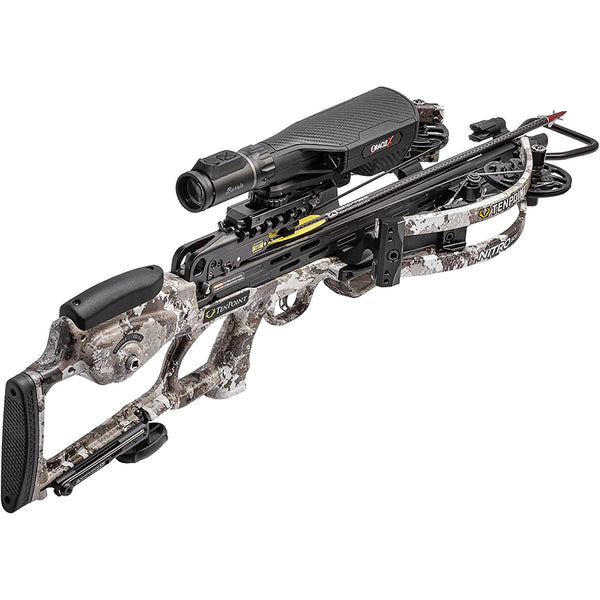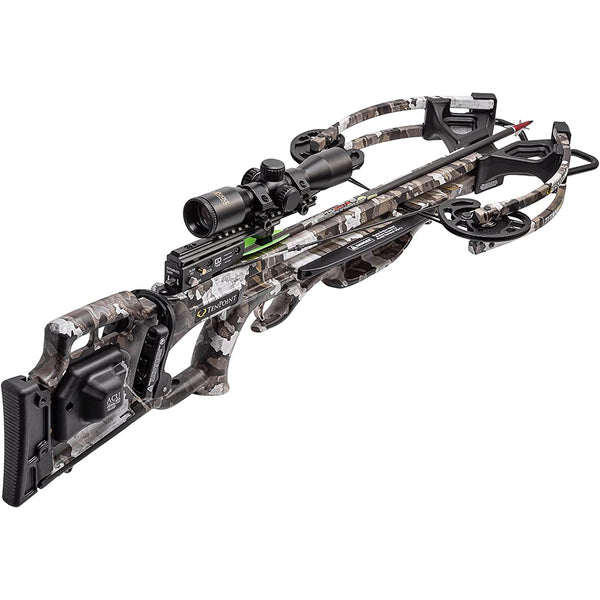The usage of crossbows is gaining popularity among hunters and target archers. Compared to compound or recurve bows, they are simpler to handle and can shoot bolts with high accuracy even at long distances. Scopes can be added to enhance precision and they can be held like a rifle.
If you’re interested in purchasing a crossbow, but are not sure which one to get, this guide is for you. We put together this guide to cover the main crossbow types and the specs you should consider. So lets get started.
Reverse Limb Crossbow

Reverse limb crossbows are a recent innovation that differs from traditional bows in the orientation of its limbs. Instead of being connected at the front, the limbs curve forward and connect at the back. However, this does not mean that they are turned around completely.
Rather, they are perpendicular to the bow and attached at the rear. The cams are still located at the front, which is where the bowstring is attached. When the bowstring is pulled back, it pulls the limbs inward, storing energy.
One significant benefit of reverse limb crossbows is that they reduce the axle-to-axle limb length, making them more maneuverable during hunting. Additionally, their center of gravity is located at the rear, making them easier to control and quieter when fired.
However, the primary advantage of this design is increased power, as the bowstring pushes against a longer length of bolt shaft due to the cams being located at the front. The downside is that these crossbows can be difficult to find and maintain due to their complex technology.
Check out the TenPoint Nitro 505 Oracle X!
It is the swiftest crossbow on the market, boasting an impressive velocity of 505 feet per second. Its reverse-draw configuration ensures optimal balance, making it a formidable weapon of choice.
Pistol Crossbow
Pistol crossbows are crossbows that can be fired using only one hand. They are essentially smaller versions of the recurve crossbow and lack a shoulder stock for support. Some models are designed to be "self-cocking," which does not imply that they are automatic firearms.
Instead, they feature a simple lever for cocking the crossbow, as opposed to the arduous process of drawing a conventional crossbow using a foot in the cocking stirrup. In essence, they are identical to larger crossbows, but in a more compact form.
Automatic/Repeating Crossbow

Repeating crossbows are equipped with a magazine similar to that found on modern repeating rifles. This magazine holds a stack of five to 10 bolts, which are positioned on top of the crossbow. The bowstring is secured in a groove inside the magazine when it is in a relaxed state.
To prepare for shooting, a lever located at the back of the crossbow is used to pull the magazine back, simultaneously moving the bowstring. Once the bowstring reaches the fully cocked position, the lever pushes it out of the groove, allowing it to make contact with the bolt and propel it forward.
As this happens, the next bolt in line falls into place. By simply manipulating the lever back and forth, one can rapidly shoot through the entire magazine in a matter of seconds.
Check out the Titan De-Cock Crossbow with ACUdraw.
It includes the innovative D1 Trigger and ACUdraw 50 SLED De-Cock system. It provides a safe and effortless de-cocking experience, while also offering easy cocking and a remarkable shooting speed of 370 feet per second. The Titan De-Cock is a lightweight option that comes with the D-1 Trigger, a unique two-stage design that ensures a consistent and satisfying 3.5-pound pull without any unwanted movement.
Compound Crossbow
Compound crossbows derive their name from the fact that they employ a compound pulley system to increase the bowstring's power while reducing the length of the limbs. These pulleys, known as cams, are responsible for the crossbow's impressive power, and understanding their physics is crucial.
Check out the Ravin Crossbow Kit R500
The package offers exceptional accuracy and precise outcomes with its innovative Versadrive Cocking System and Hexcoil Cam System. The Versadrive Cocking System utilizes an internal screw drive to smoothly operate the Trac Trigger Firing System (TTFS), while an internal clutch prevents over-cocking and enables the user to pause or resume the cocking and uncocking process at any point.
Crossbow Specs
Here are the main specs you should consider while you are looking for a new crossbow.
Draw weight
The draw weight refers to the amount of force needed to pull the bowstring back to a cocked position without any external assistance. To provide a point of reference, a pistol crossbow typically has a draw weight of 50 pounds. For hunting animals ranging from large rabbits to whitetail deer, a draw weight of approximately 150 pounds is recommended. However, for dangerous animals like bears or moose that may charge at you, a draw weight of around 200 pounds is necessary.
Power stroke
The power stroke of a crossbow is a crucial yet often misunderstood aspect of its design. It refers to the distance between the bowstring's resting point and its fully drawn position, much like the draw length on a regular bow. Generally speaking, longer draw lengths result in higher arrow speeds, particularly in recurve crossbows.
However, there are numerous other factors that can impact arrow velocity, making it a complex calculation. As such, power stroke is often used as a simplified means of comparing different crossbows.
Speed
When evaluating the speed of a bow's performance, there are two distinct measurements to take into account. One measurement is the velocity of the arrow, which is measured in Feet per Second (fps). This measurement simply indicates how quickly the arrow is traveling and remains relatively consistent regardless of the distance from which it is shot.
Arrow velocities typically fall within the range of 200 fps to 400 fps. The second measurement to consider is the amount of kinetic energy. This is measured in Foot Pounds of Kinetic Energy (fpke). Unlike arrow velocity, this measurement reveals the amount of energy that is transferred to the target by the arrow.
It is important to note that kinetic energy decreases as the distance increases, so this factor must be taken into consideration. Generally, kinetic energy ranges from approximately 30 fpke to 125 fpke.
Ready to Up Your Crossbow Game?
Explore our premium crossbows and accessories to elevate your accuracy and hunting game. Visit Optics Force today and gear up for precision like never before. Your next bullseye is just a click away.
Crossbow FAQ
Can I dry-fire my crossbow?
Although it is possible, it is not recommended as it can potentially harm the equipment. Even though certain models have mechanisms that prevent dry firing by catching the string if it is unintentionally released, it is still important to exercise caution when handling an unloaded and cocked crossbow to ensure both your safety and the equipment's well-being
How is a crossbow different from a vertical bow?
A crossbow is composed of a stock holding a horizontal limb assembly which propels bolts. A mechanism holds the bowstring in place until the trigger is pulled, releasing the energy stored in the limbs and launching the bolt. This makes it similar to a firearm in terms of handling.
On the other hand, a vertical bow is held upright and shoots arrows. The bowstring is drawn manually and the energy stored in the limbs is released upon releasing the bowstring, propelling the arrow forward.
